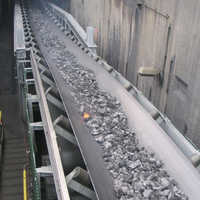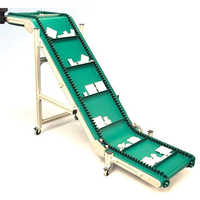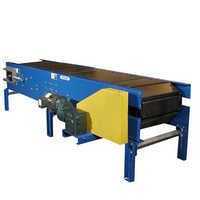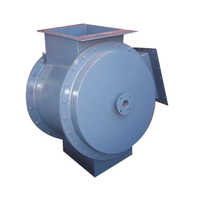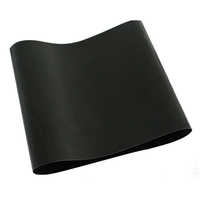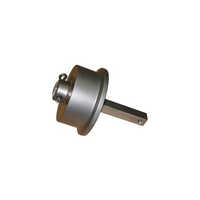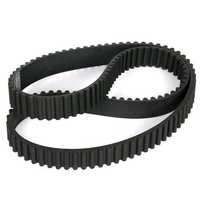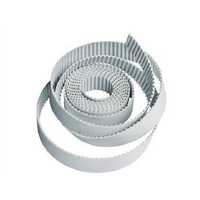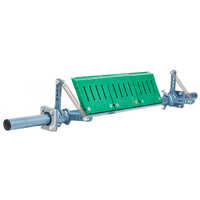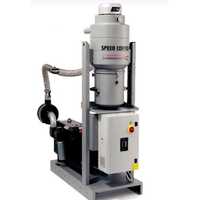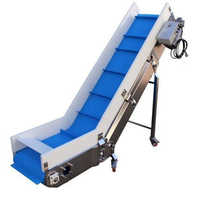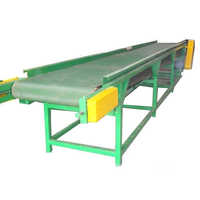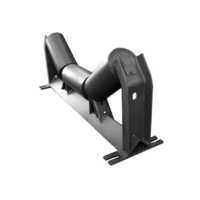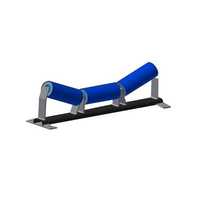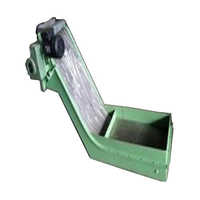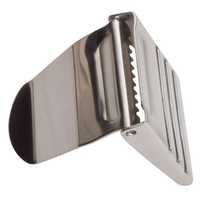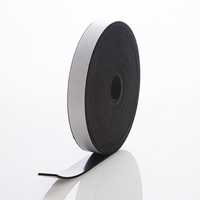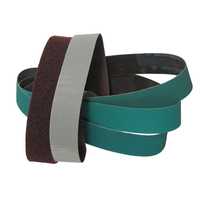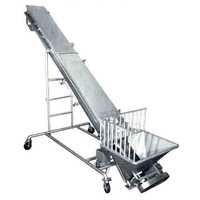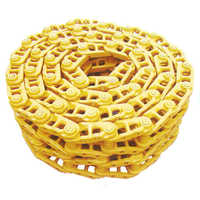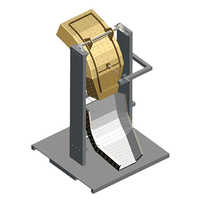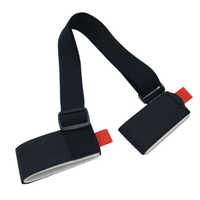Conveyor & Conveyor/Industrial Belts
(10872 products)
Conveyor belts, an essential component of various industries, are characterized by their flexibility, durability, and ability to transport materials efficiently. They are made of strong materials that resist wear and tear, ensuring long-lasting performance. Conveyor belts find applications in industries like food processing, manufacturing, mining, and packaging. Industrial conveyor belts are designed for heavy-duty applications, offering high strength and resistance to chemicals and mechanical stresses. They are used in conveying materials such as aggregates, coal, and minerals. Conveyor belts also come in different types, each tailored to specific applications. Balanced belts, double balanced belts, gratex belts, and compound balanced belts are commonly used in various industries. Overall, conveyor belts are versatile and indispensable in material handling systems, facilitating efficient and reliable transportation of goods and materials.
...show moreConveyor belt pulleys are utilized in transmission systems powered by conveyor belts, typically in low-power, high-speed applications.
Idler pulleys support the conveyor belt, maintaining its alignment and preventing excessive sagging.
Conveyor pulleys are typically constructed from steel or M.S., with or without a rubber coating.
Crowned pulleys help center the belt, prevent rubbing against flanges, and provide support under the belt's center, where stress is highest.
Industrial conveyor belts offer advantages such as cut resistance, high strength, low stretch, wear resistance, and antistatic properties.
Explore More Categories
Made in India
Black And Brown Gravity Conveyor
MOQ - 1 Unit/Units
Product Type - Gravity Conveyor
Usage - Industrial
Color - Black and Brown
16 Years
Business Type: Manufacturer | Supplier
FUTURE INDUSTRIES PVT. LTD.
Silver Work Leveler Roller
Price: 10000 INR (Approx.)/Number
MOQ - 10 Number
Usage - Roller leveling. Roller leveling is essentially a bending process. The out of flat part, sheet or plate is deformed by a series of alternating bends.
Color - Silver
Product Type - work leveler roller
5 Years
Business Type: Manufacturer | Exporter
EMCO ENGINEERING
Made in India
Gray Online Check Weigher Belt Conveyor
Price: 800000.00 INR (Approx.)/Unit
MOQ - 1 Unit/Units
Usage - Box, Packages
Product Type - Belt Conveyor
Height - 800 Millimeter (mm)
6 Years
Business Type: Manufacturer | Supplier
INTEGRATED CONVEYORS AND PACLINE AUTOMATION TECHNOLOGIES
Made in India
Blue Skip Hoist
Price: 395000 INR (Approx.)/Unit
MOQ - 1 Unit/Units
Size - Customized
Product Type - Skip Hoist
Usage - Industrial
14 Years
Business Type: Manufacturer | Supplier
SIGMA INSTRUMENTATION
Made in India
Stainless Steel Packing Belt Conveyor
Price: 80000 INR (Approx.)/Unit
MOQ - 1 Unit/Units
Usage - It is used for transferring of goods.
Material - Stainless Steel
Type - Belt Conveyor
11 Years
Business Type: Manufacturer | Exporter
NU PHARMA ENGINEERS & CONSULTANT
Made in India
Blue Automatic Belt Conveyor
Price: 75000 INR (Approx.)/Unit
MOQ - 1 Unit/Units
Product Type - Automatic Belt Conveyor
Usage - Industrial
Color - Blue
3 Years
Business Type: Manufacturer | Supplier
MAGNA TRONIX
Made in India
High Strength And Galvanized Packing Belt Conveyor
Price: 125000 INR (Approx.)/Piece
MOQ - 2 Piece/Pieces
Color - Blue
Product Type - High Strength Packing Belt Conveyor
Material - PVC
17 Years
Business Type: Manufacturer | Supplier
JOIN PACK MACHINES (PVT.) LTD.
Indian Inquiries Only
Telescopic Belt Conveyor
Price: 750000 INR (Approx.)/Piece
MOQ - 1 Piece/Pieces
Product Type - Telescopic Belt Conveyor
Material - Mild Steel
Voltage - 240 Volt (v)
2 Years
Business Type: Manufacturer
PARUL ENGINEERING PRIVATE LIMITED
Automatic Packing Belt Conveyor
Price: 280000 INR (Approx.)/Unit
MOQ - 1 Unit/Units
Usage - Industrial
Product Type - Automatic Packing Belt Conveyor
Size - Different available
3 Years
Business Type: Manufacturer
AUTO POWER PACK
Made in India
Cooling Conveyors - Color: As Per Requirement
Price Trend: 745000.00 - 1675000.00 INR (Approx.)/Piece
MOQ - 1 Piece/Pieces
Usage - As per Requirement
Color - As per Requirement
Product Type - Cooling Conveyor
9 Years
Business Type: Manufacturer | Distributor
MNT INDUSTRIES
Indian Inquiries Only
Made in India
Hopper Loading Machine Rated Voltage: 220V Volt (V)
Price: 45000 INR (Approx.)/Piece
MOQ - 1 Piece/Pieces
Voltage - 220V Volt (v)
Usage - Air convening
Rated Voltage - 220V Volt (V)
14 Years
Response Rate: 82.22%
Business Type: Manufacturer | Exporter
RE BLOWERS INDIA PRIVATE LIMITED
Metal Truck Loading And Unloading Conveyor
Price: 185000 INR (Approx.)/Piece
MOQ - 1 Piece/Pieces
Material - Metal
Type - Belt Conveyor
Structure - Belt
20 Years
Business Type: Manufacturer | Supplier
SHRI VINAYAK PACKAGING MACHINE PVT. LTD.
Indian Inquiries Only
Rubber Conveyor Belt
Price: 400.00 INR (Approx.)/Meter
MOQ - 10 Meter
Material - Rubber
Type - Belt Conveyor
Structure - Belt
17 Years
Business Type: Manufacturer | Supplier
SOFTEX INDUSTRIAL PRODUCTS PVT. LTD.
Made in India
Packaging Side Table Belt Conveyor Usage: Industrial
Price: 85000.00 INR (Approx.)/Piece
MOQ - 1 Piece/Pieces
Usage - Industrial
Type - Belt Conveyor
Structure - Belt
7 Years
Business Type: Manufacturer | Supplier
SIDDHIVINAYAK ENGINEERING
Pvc Belt Conveyors Speed: 2 M/S
MOQ - 1 Piece/Pieces
Width - 2000 Millimeter (mm)
Structure - Roller
Belt Conveyor - Flat Belt
13 Years
Business Type: Manufacturer
MODERATE MACHINES (PVT.) LTD.
Indian Inquiries Only
Made in India
Pneumatic Conveyor For Powder Load Capacity: 2-10 Tonne
Price: 300000.00 INR (Approx.)/Unit
MOQ - 1 Unit/Units
Usage - Powder
Product Type - Pneumatic Conveyor For Powder
Material - MS AND SS
11 Years
Business Type: Manufacturer | Exporter
ALTOMECH PRIVATE LTD.
Soft Rough Top Conveyor Belts
Price Trend: 70.00 - 600.00 INR (Approx.)/Ton
MOQ - 0.5 Ton/Tons
Hardness - 20-80 A
Weight - 100-135 Kilograms (kg)
Natural Rubber - Rubber
8 Years
Response Rate: 78.79%
Business Type: Manufacturer | Exporter
RAVASCO TRANSMISSION AND PACKING PRIVATE LIMITED
Ss Type Feeding & Stacking Inkjet Conveyor
MOQ - 1 Piece/Pieces
Material - SS type
Structure - Belt
Belt Conveyor - Flat Belt
7 Years
Business Type: Manufacturer
SHRI VINAYAK PACKAGING MACHINE PRIVATE LIMITED
Indian Inquiries Only
Made in India
Green Screw Conveyor
Price: 100000 INR (Approx.)/Piece
MOQ - 1 Piece/Pieces
Color - Green
Material - Carbon Steel, Stainless Steel
Load Capacity - 100-150 per feet Kilograms (kg)
20 Years
Business Type: Manufacturer | Distributor
MITSUN ENGINEERING
Verified Exporter
( Accepts only Foreign Inquiry)
Made in India
Excellent Strength And Rust Proof PVC Conveyors Machine
Price: 50000 INR (Approx.)/Piece
MOQ - 5 Piece/Pieces
Color - Silver
Usage - Industrial
Product Type - PVC Conveyors Machine
7 Years
Business Type: Manufacturer | Exporter
JETPACK MACHINES PVT. LTD.
Made in India
Yellow Mixing Screw Feeder
Price: 100000 INR (Approx.)/Unit
MOQ - 1 Unit/Units
Usage - Industrial
Product Type - Mixing Screw Feeder
Size - Custom
21 Years
Business Type: Manufacturer | Exporter
SUNRISE PROCESS EQUIPMENTS PRIVATE LIMITED
Made in India
L-Sealer Conveyor - Automatic Grade: Semi-Automatic
Price: 100000 INR (Approx.)/Unit
MOQ - 1 Unit/Units
Color - Orange
Product Type - L Sealer With Conveyor
Type - L-Sealer Conveyor
9 Years
Response Rate: 70.42%
Business Type: Manufacturer | Distributor
SMART PACKAGING SYSTEM
Indian Inquiries Only
Made in India
Horizontal Spectrum Industrial Conveyor Belt
Price: 70000 INR (Approx.)/Piece
MOQ - 5 Piece/Pieces
Color - Cream
Usage - Industrial
Product Type - Spectrum Industrial Conveyor Belt
22 Years
Business Type: Manufacturer | Distributor
SPECTRUM INDUSTRIES
Made in India
Fire Resistance MultiRail Overhead Conveyor System
Price: 400000 INR (Approx.)/Unit
MOQ - 1 Unit/Units
Usage - Industrial
Color - Red and Yellow
Product Type - Fire Resistance MultiRail Overhead Conveyor System
16 Years
Business Type: Manufacturer | Exporter
DTRA ENGINEERS
Made in India
Polyester Rack Belt Size: 1.2 Mm (Thickness)
Price: 850 INR (Approx.)/Piece
MOQ - 100 Piece/Pieces
Size - 1.2 mm (Thickness)
Product Type - Rack Belt
Usage - Industrial
4 Years
Business Type: Manufacturer | Distributor
FORCELIFT MATERIAL MOVEMENTS
Indian Inquiries Only
Made in India
Ss Industrial Pneumatic Conveying
MOQ - 1 Unit/Units
Size - Standard
Usage - Industrial
Product Type - Industrial Pneumatic Conveying
Business Type: Manufacturer | Distributor
PROMINENCE SYSTEMS PVT LTD
Made in India
Chain Conveyor
Price: 28000 INR (Approx.)/Unit
MOQ - 1 Unit/Units
Product Type - Chain Conveyor
Size - 3/4 Inch
Usage - industrial
19 Years
Business Type: Manufacturer
JOY PACK INDIA PVT LTD
Indian Inquiries Only
Made in India
Spiral Conveyor Belt
Price: 40 INR (Approx.)/Piece
MOQ - 100 Piece/Pieces
21 Years
Business Type: Manufacturer | Distributor
INTERNATIONAL WIRENETTING INDUSTRIES
Conveyor & Conveyor/Industrial Belts Manufacturers | Suppliers in India
| Company Name | Location | Member Since |
|---|---|---|
| Spectrum Industries | Mangaluru, India | 22 Years |
| Sunrise Process Equipments Private Limited | Mumbai, India | 21 Years |
| International Wirenetting Industries | Palghar, India | 21 Years |
| Shri Vinayak Packaging Machine Pvt. Ltd. | New Delhi, India | 20 Years |
| Mitsun Engineering | Vadodara, India | 20 Years |
| Joy Pack India Pvt Ltd | Delhi, India | 19 Years |
| Join Pack Machines (Pvt.) Ltd. | Delhi, India | 17 Years |
| Softex Industrial Products Pvt. Ltd. | Kolkata, India | 17 Years |
| Future Industries Pvt. Ltd. | Ahmedabad, India | 16 Years |
| Dtra Engineers | Bahadurgarh, India | 16 Years |
What Are Conveyor Belts?
Introduction
Belt conveyors are one variety of conveyor systems, with the belt itself serving as the transport medium. Diverse modules are needed for each conveyor system to carry out its duties.
Weight, speed, and product throughput on the conveyor system are only a few factors that might determine the variety of activities involved.
An unending loop of carrying medium, the conveyor belt, spins around two or more pulleys (called drums) to create a pull effect for the products it is transporting. The belt and its load are pushed along by one or more motorized pulleys. In use since the nineteenth century, conveyor belts are a tried and true method of transport. Beginning in 1892, Thomas Robins invented the first conveyor belt to transport coal, ores, and other materials.
For the first time ever, mass manufacturing and batch production were both possible once Henry Ford installed conveyor-belt assembly lines in the Ford Motor Company facility.
What Are Conveyor Belts Used For?
Conveyor systems have many applications in industry, but their primary goal is to reduce labor costs while boosting throughput in a given area of production or transportation. This allows for a greater volume of products to be processed and shipped to customers more quickly.
Conveyor systems typically lower the space necessary to transport objects, allowing the operation to run in a smaller section of the facility and order to free up the office area, as a result of the reduced labor needed to carry out the task.
Although conveyors have widespread application across many sectors, they are particularly common in the warehousing and industrial sectors. Hermes' national sorting hub is one location where you can find them. The hub has benefited greatly from the addition of an automated conveyor system due to the significant boost in throughput it provides.
Belt conveyors can be made with curved portions that employ tapered rollers and curved belting, with optional parts like guards, gates, convergers, RFID scanners, and more to facilitate access to various points along the conveyor and prevent harm to the goods being transported.
Belt conveyors are the most popular type of powered Conveyor & Conveyor/Industrial Belts due to their low cost, adaptability (carrying items large and small, light and heavy, with jiggly edges and square boxes), and widespread availability.
What Are the Advantages of Conveyor Belts?
1. Reduces the Need for Hand-Pulled Effort
Much of the work done in the food sector involves the processing and management of bulk commodities. Miniature conveyor belts can significantly reduce the need for physical handling. They have the ability to completely replace humans in the workplace.
Prior to the widespread use of conveyors, the transportation of food products was a laborious, time-consuming, and inefficient procedure. The old saying that "time is money" is still true in many fields. The food business is not an exception.
Many restaurants and other food services lose production because they rely only on human labor. Due to this, money is lost.
2. Conveyor Belts Reduce Accidents
Pulleys, idlers, rollers, and tensioners are only a few of the many moving elements in mechanical systems. Because of conveyors, workers rarely have to interact with them and are less in danger than they would be if they had to move large loads themselves.
Newer conveyors also pose the reduced danger of mechanical breakdown and personal injury. Furthermore, as labor efficiency rises, fewer people will need to be present on the factory floor at any given time. As a result, there are fewer workers that need to be managed and supervised.
As an added bonus, workers are most likely to be located along the conveyor's edge. They won't have to touch any of the moving parts (unless maybe while doing repairs) unless absolutely necessary. This is a fantastic strategy for lowering risk at work.
Conveyors Improve Food Quality and Safety
You presumably prefer foods that haven't been handled by humans too often, and that's what we've got for you here. Conveyors are a great way to increase food safety, especially considering that so many items in today's supermarkets are produced in factories and warehouses.
Conveyor systems have improved greatly over the years, with many modern models including built-in hygiene features to ensure that goods and consumables remain contaminant-free. Dust-free and contamination-free conditions are crucial for food and drink goods prior to shipping.
An important part of being in compliance with the FDA and USDA is maintaining a clean and contaminant-free environment. A facility could be shut down or subject to fines if they fail to comply with government requirements. However, modern conveyor technology makes compliance much simpler for most establishments.
How Many Types of Conveyor Belts?
1. Sanitary and Washdown Conveyors
Objects coming out of ovens or freezers can be transported on these conveyors without losing any heat. Additionally, equipment used in the food business, in particular, must be able to withstand being submerged in glaze, breading, or hot oil. Larger washdown conveyors with flat wire belts are ideal for discharging broken bulk cargo like oil drums and crates from ships since they can safely handle both wet and oily objects.
2. Incline & Decline Belt Conveyors
Belt conveyors with an incline are driven in the middle by a gear motor and have a single or double-nosed take-up. And unlike smooth-belted conveyors, the belt on this model is rough, making it well-suited for vertical transport. Cleats on the belts of the conveyors allow for the systems to cross over one another, allowing for the safe transfer of goods to many levels without the risk of product spillage.
3. Curved Belt Conveyors
These belt conveyors have a curved frame that allows them to move products around corners, accommodate tight transfers, and make the most efficient use of available space. The arcs of these belts can reach 180 degrees.
Flat belts are the only option for truly curved conveyors that don't have any straight runs before or after the bends, as the straight lines are necessary for the modular plastic belts to function properly. In order to redirect the flow of bags and other goods, curved belt conveyors are commonly employed in bag handling systems.
4. Cleated Belt Conveyors
Belt conveyors that use cleats are called cleated belt conveyors, and they have cleats or obstacles in the vertical direction. These cleats have many uses, including securing goods on inclines and declines, providing uniform distances between objects, and many others. In addition, there is a wide variety of cleats to suit a variety of needs.
This cleat is more resistant to leverage pressures thanks to its wide base. The curved faces of certain of these cleats make it possible for them to scoop granules. When used on steeper inclines, this cleat's lighter and medium-weight load capacities come in handy.
5. Modular Belt Conveyors
Conveyor belts made of modular components are ideal for use in situations where the conveyor needs to turn sharp corners. They just need one belt and one motor for all of their motion, and they can go in any direction, including straight, around a corner, up and downhill. While technically possible with different conveyor types, doing so would require extensive tailoring and significant expenses.
To further accommodate unique conveyor layouts, modular plastic belts can be used without affecting belt tracking. Belts that are wider than they are long are one such option, as they give the necessary stability for working with fragile packaging like soft plastic bags, cardboard boxes, and shrink wrap.
6. Flat Belt Conveyors
As one of the most common types of conveyor in use today, the flat belt conveyor belt is an important piece of modern industry. Moving goods about an establishment, or "internal conveyance," is a good use case for flat belts.
A continuous flat belt, made of either natural or synthetic material (polyester, nylon), is moved along a set of motorized pulleys in this type of conveyor belt. Products are loaded onto the moving belt and transported between terminals.
When it comes to wash-down areas, sluggish assembly lines, and industrial settings, flat belt systems tend to reign supreme. When equipped with the proper belt, it may also safely transport fragile, perishable products despite their size, softness, or unusual shape.
7. Roller Bed Conveyor Belts
When things are loaded onto the belt using gravity, a roller bed configuration is appropriate. This is due to the fact that mechanical shock from hand-loading might cause the rollers to break. Roller bed conveyor belts are another viable choice for long-distance transport due to the fact that they reduce friction and facilitate the movement of products along the belt.
These belts can be used for a wide variety of tasks, including conveying goods, inspecting them, assembling them, and more. Roller bed conveyor belts are frequently utilized in luggage handling systems and mail sorting facilities.
FAQs: Conveyor & Conveyor/Industrial Belts
Q. How much is a conveyor belt cost?
Ans: The cost of conveyor belt is between Rs 250/meter too Rs 2000/Meter in India.
Q. Which conveyor belt is best?
Ans: Econo Pac 120 is the best conveyor belt in India. They work great for transporting boxes, totes, as well as other things along horizontal conveyors.
Q. How long do conveyor belts last?
Ans: The average lifespan of a belt is three years. There is either a flaw in the system's design, significant problems with the system, or the belt is inappropriate for the application if it needs to be replaced more often.
Q. What is m24 in conveyor belt?
Ans: Items such as granite, metallic ores, coal, limestone, clinker, Blast furnace slag, etc. are too heavy, too sharp, or too abrasive to be transported with anything less than this Grade.
Related Categories
Abrasives
Acoustic Products
Acrylic Sheets
Air Blowers
Air Compressors & Air Separation Plants
Air Cooler
Air Dryers
Air Receiver
Air Valves
Aluminum Castings
Anchors
Anti Vibration Mounts
Ball & Roller Bearings
Ball Valves
Ballast Making Machines
Bearing Parts & Components
Bearings
Bellows & Expansion Joints
Belt Pulleys
Boilers, Components & Spares
Bolts
Bright Bars
Bristles
Burners/Industrial Burners & Incinerators
Bushings & Bushing Parts
Butterfly Valves
CNC Machined Components
Cable Pulleys
Capital Goods
Carbon & Graphite Products
Castor Wheels
Centrifugal Pumps
Centrifuges
Ceramics
Chains & Chain Link Fence Fittings
Cleaning Equipment
Clips, Clamps
Coils
Combustion Equipment
Compression Springs
Compressors & Allied Equipment
Control Valves
Conveyor & Conveyor/Industrial Belts
Cooling Tower & Chilling Plants
Corrosion Protection Materials
Coupling
Cranes
Cryogenic Equipment
Cutting Tools, Broaches & Cutters
Departmental Shelving
Diaphragm Valves
Die Castings
Dies & Moulds
Dies,Jigs,Fixtures
Diesel Engine & Electric Locomotive Spares
Draught Fan
EOT Cranes
Electric Hoists
Electric Motors & Engines
Electroplating Chemicals & Equipment
Elevators, Lifts & Escalators
Energy Management System
Engine Valves
Engineering Goods & Equipment
Engineering Plastics
Engraving Equipment
Extruded Profiles
Fasteners
Fiberglass Products
Filter Cartridges & Media
Filter Cloth, Filter Industrial
Filters-Air, Gas, Liquid
Filtration & Sedimentation Units
Flat Metal Processing Equipment
Float Valves
Fork Lift Truck Parts
Fork Lift Trucks
Forklifts
Foundry Raw Material & Equipment
Furnace Manufacturers
Galvanized Fasteners
Gantry Cranes
Gaskets
Gate Valves
Gauges & Gauge Glasses
Gear Boxes, Reduction Gears & Gear Cutting
Girder Cranes
Glass & Glass Products
Glass Cutting Tools/Glass Cutters
Globe Valves
Goliath Cranes
Grating
Hand & Allied Tools
Hand Pump
Hardware & Tools
Heat Exchangers
Heating Elements
Hex Bolts
Hex Nuts
Hooks & Mounts
Hoses
Hot Air Oven
Humidification & Ventilation Equipment
Hydraulic Hoses & Flexible Metal
Hydraulic Press
Hydraulic Press Brakes
Hydraulic Products & Equipment
Hydraulic Valves
Induction Heating Equipment
Industrial Automation
Industrial Brakes
Industrial Brushes
Industrial Clothing
Industrial Clutches
Industrial Cylinders
Industrial Dryers
Industrial Evaporators
Industrial Knives
Industrial Nets
Industrial Ovens
Industrial Rollers
Industrial Supplies Stocks
Industrial Supplies-General
Industrial Tape
Industrial Tools
Industrial Valves
Industrial Vibrator
Inspection Equipment
Instrumentation
Internal Combustion Engine
Jib Cranes
Laboratory Furniture
Laboratory Glassware & Equipment
Laundry Equipment
Lined Valves
Machine Tools Accessories
Marking Systems
Material Handling Equipment
Measuring Tools & Equipment
Mechanical Seals
Metallised Capacitor Films
Mining Equipment
Mining, Exploration & Drilling Machinery
Model Making Materials
Motor Couplings
Moulded Components
Moulds
Needle Valves
Needles
Nuts
Oil Seals
Outdoor Cooling Systems
Overhead Cranes
PVC Hoses
PVC Products
Paint Brushes
Painting Equipments & Maintenance
Perforated Sheets
Plastic Processing Machinery Parts
Plastic Valves
Plastic Welding Equipment
Plate Valves
Plug Valves
Pneumatic Products & Tools
Pneumatic Valves
Polish & Polishing Material/Machinery
Power Press
Precision Brass Components
Pressed Components
Pressure Gauges
Pressure Vessels
Pulleys
Pulverizers
Pump Spares Parts
Pumps & Pumping Equipment
Radiators
Refrigeration & Equipment
Rope Pulleys
Rope,Twines & Webbings
Ropes
Rotary Valves
Rubber & Rubber Products
Rubber Gaskets
Rubber Roller
Rubber Seals
Rubber Transmission Belts
Screws
Seals
Sensors & Transducers
Shaft Couplings
Shafts & Shaft Collars
Sheet Metal Components & Parts
Solenoid Valves
Springs
Stainless Steel Bolts
Stainless Steel Fasteners
Stainless Steel Nuts
Stainless Steel Valves
Storage Systems
Storage Tanks
Submersible Pumps
Surface Finishing Equipment
Synthetic Industrial Diamonds
Testing & Measuring Equipment
Thermostatic Bimetals & Thermostats
Trolleys & Carts
Tungsten Carbide
Ultrasonic Equipment
V-Belts
Vacuum Equipment & System
Valves
Valves Fittings
Vibrating Screen
Washers
Water Coolers
Weighbridge
Welding & Soldering Supplies
Welding Electrodes
Welding Equipment
Winches
Wire Drawing Dies
Wire Rope Hoists
Wire Ropes
